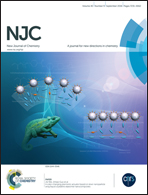Novel non-spherical deltahedra in trirhenaborane structures†
Abstract
The geometries and energetics of the trirhenaboranes Cp3Re3Bn−3Hn−3 (Cp = η5-C5H5; n = 5 to 12) have been investigated using density functional theory for comparison with the experimentally known oblatocloso dirhenaboranes Cp*2Re2Bn−2Hn−2 (Cp* = η5-Me5C5; n = 8 to 12). The low-energy Cp3Re3Bn−3Hn−3 (7 ≤ n ≤ 12) structures are found to be Re3Bn−3 deltahedra with internally bonded Re3 triangles. The rhenium atoms are generally located at degree 6 to 8 vertices representing sites of low local curvature and the boron atoms at degree 3 to 5 vertices representing sites of high local curvature. The Re–Re bonds in the Re3 triangles of such clusters typically range from 2.6 to 2.7 Å if they are located on or near the deltahedral surface and from 2.8 to 3.0 Å if they go through the interior of the deltahedron away from the surface. Such highly non-spherical structures, typically having little symmetry, are related to the oblatocloso structures of the dirhenaboranes. A low-energy, more nearly spherical 12-vertex Cp3Re3B9H9 structure, essentially degenerate with the global minimum, has an Re–Re–Re chain embedded in a deltahedron having degree 5 and 6 rhenium vertices and degree 4 and 5 boron vertices. Low-energy structures for the 5-vertex Cp3Re3B2H2 system are derived from a trigonal bipyramid. Similarly, low-energy 6-vertex Cp3Re3B3H3 structures have central Re3B3 bicapped tetrahedra.


 Please wait while we load your content...
Please wait while we load your content...